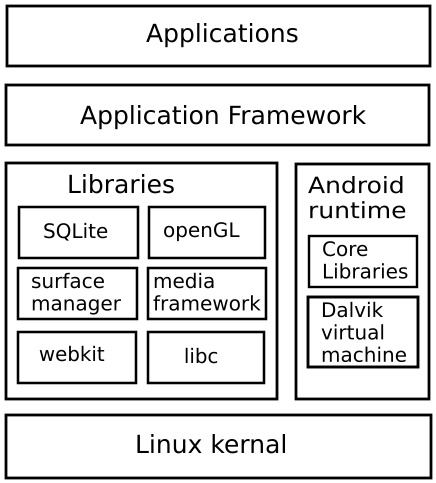The Android operating system was designed by the Open Handset Alliance (led primarily by Google) and was developed for Android smartphones and tablet computers. Whereas ios is designed to run on Apple mobile devices and is close-sourced, Android runs on a variety of mobile platforms and is open sourced.

Architecture of Google's Android Operating System
Android is similar to ios in that it is a layered stack of software that provides a rich set of frameworks for developing mobile applications. At the bottom of this software stack is the Linux kernal, although it has been modified by Google and is currently outside the normal distribution of Linux releases.
Linux is used primarily for process, memory, and device-driver support for hardware and has been expanded to include power management. The Android runtime environment includes a core set of libraries as well as the Dalvik virtual machine. Software designers for android devices develop applications in the Java language. However, rather than using the standard Java API, Google has designed a separate Android API for Java development. The Java class files are first compiled to Java bytecode and then translated into an executable file that runs on the Dalvik virtual machine. The Dalvik virtual machine was designed for Android and is optimized for mobile devices with limited memory and CPU processing capabilities.
The set of libraries available for Android applications includes frameworks for developing web browsers (webkit), database support (SQLite), and multimedia. The libc library is similar to the standard C library but is much smaller and has been designed for the slower CPUs that characterize mobile devices.
About the Authors
Abraham Silberschatz is the Sidney J. Weinberg Professor of Computer Science at Yale University. Prior to joining Yale, he was the Vice President of the Information Sciences Research Center at Bell Laboratories. Prior to that, he held a chaired professorship in the Department of Computer Sciences at the University of Texas at Austin.
Professor Silberschatz is a Fellow of the Association of Computing Machinery (ACM), a Fellow of Institute of Electrical and Electronic Engineers (IEEE), a Fellow of the American Association for the Advancement of Science (AAAS), and a member of the Connecticut Academy of Science and Engineering.
Greg Gagne is chair of the Computer Science department at Westminster College in Salt Lake City where he has been teaching since 1990. In addition to teaching operating systems, he also teaches computer networks, parallel programming, and software engineering.
Operating System Concepts, now in its ninth edition, continues to provide a solid theoretical foundation for understanding operating systems. The ninth edition has been thoroughly updated to include contemporary examples of how operating systems function. The text includes content to bridge the gap between concepts and actual implementations. End-of-chapter problems, exercises, review questions, and programming exercises help to further reinforce important concepts. A new Virtual Machine provides interactive exercises to help engage students with the material.
Reader Adam Sinclair says, "I'm writing this review from the perspective of a student. I am finishing an Operating Systems course at university and I have to say this book is fantastic at introducing new concepts. If there is ever a conversation about OS, I always refer to this book. The content is very well laid out and organized in a way that can be read from beginning to end. There is no need to jump from one chapter to another (unless you want to skip sections)."
Reader Chetan Sharma says, "This book is bible for operating system knowledge. It covers very important concepts of Process Management and Memory Management. This book is good for all type of readers - Beginner, Intermediate and Advanced reader. Highly recommended for Students/Professionals/Readers who want to enhance their knowledge.
More Computer Architecture Articles:
• Multiuser Operating System Functions
• Multi-Processor Scheduling
• Introduction to Microprocessor Programming
• Fundamental Digital Logic Gates
• Multicore Programming
• Logical Versus Physical Memory Addresses
• Microprocessor Counter, Clock, Timer Circuits
• The Motherboard Chipset
• Analog to Digital Convertion with a Microcontroller
• Real-Time CPU Scheduling



